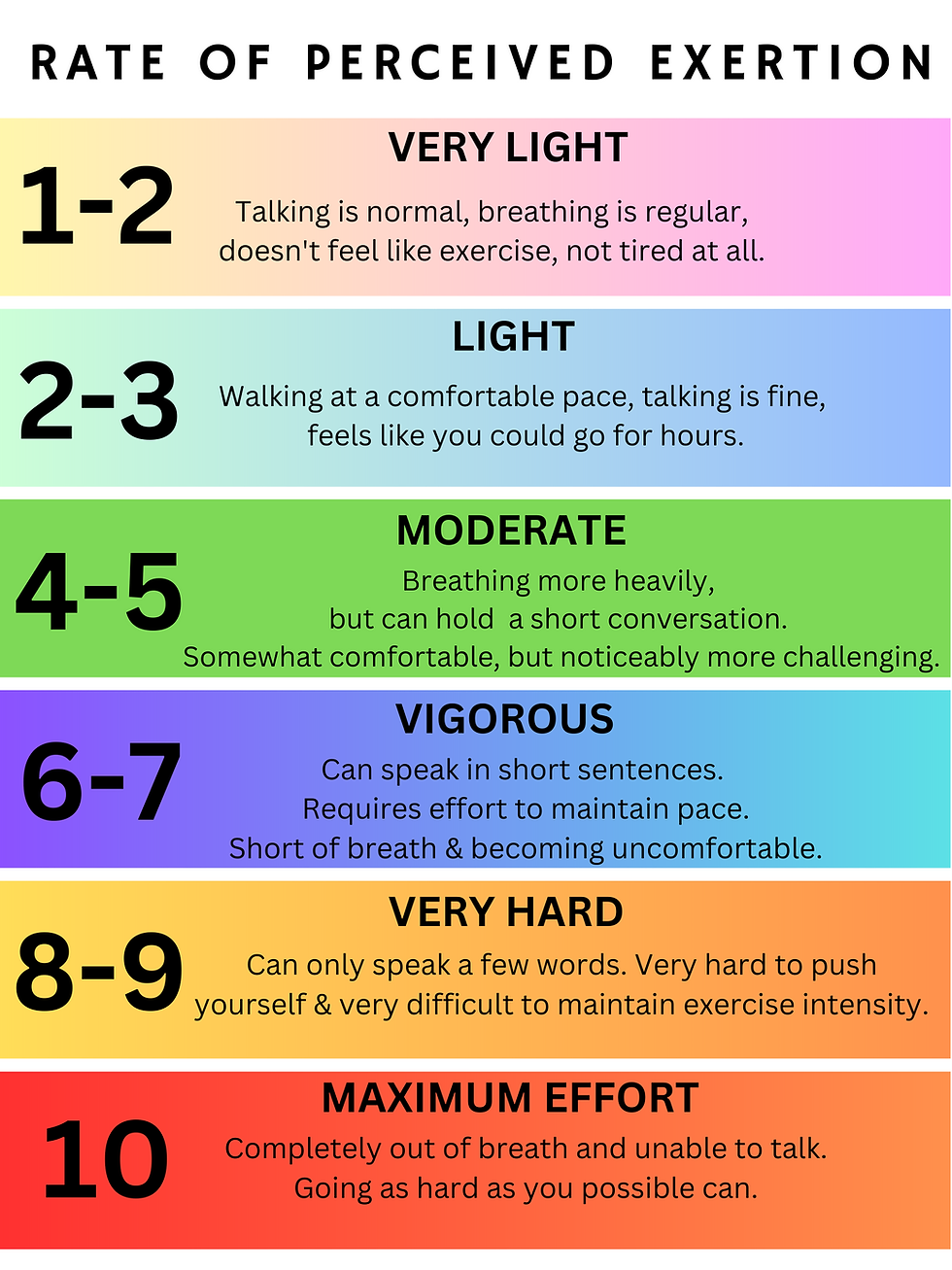How to Measure Exercise Intensity for Seniors: Learning how to use Rate of Perceived Exertion Scale.
- Jules
- Mar 26, 2023
- 4 min read
How do you determine how hard you should push yourself during a workout? When do you know if you're working out too hard, or not hard enough? What is the optimal pace that will provide me with health and fitness benefits? Let's talk about it!
A lot of people use their heart rate to judge how hard to go, but not everyone has a smart watch that shows a heart rate. There is another way to monitor intensity and it's called the 'Rate of Perceived Exertion' scale. The original scale is called the Borg RPE, which goes from 6-20 but the modified scale is easier to follow, and uses a scale from 1-10. You’ll find different variations of the scale so I created one to try to make it simple to understand, but ensured it has the needed information. I'll provide attachments at the bottom of this post so you can print it off for personal use. As you can see, there are numbers on the left from 1 to 10. Beside the number, you'll see an explanation of how you might be feeling at that level. If you're someone who enjoys going for a daily walk, think about what level you might be at while walking (look at the chart now to find the number). Keep that number in your mind as we continue to work through the chart. Now, think about when you're doing one of the cardio walking workouts on YouTube...now what level might you be in?

So what is the best level to be at? If you have been sedentary (no exercise other than walking to get to where you need to go), it would be best to start with working out at a level of 2-3 on the chart. Start with walking at a comfortable pace to start building your fitness and to start getting into the habit of moving more. When you first start, you want to find exercise that you enjoy so that you'll want to continue coming back to exercise. It's about forming a habit and making realistic goals for continuing. Often people start off going too hard, too fast, and then they quit because they are too sore and too tired. Start easy, enjoy it and think about how good you feel from moving, rather than what you expect to see in results. Within a few weeks, you can start to increase the intensity (a little bit), and move into level 4-5 which is working out at a 'moderate' pace. Let's take a step back and talk about what the levels mean for your health.
I asked you earlier what level you feel you are at when you go for a walk. If you're a walker (whether it's daily or less), would you be able to walk for hours as you walk? I am guessing most of the answers will be yes (likely at level 2-3). Walking is great exercise, and definitely beneficial for your heart and your health (and for social aspects if you are walking with a friend or with a group). But, there are many ways to get in more fitness benefits, in less time. If you are walking to improve your fitness, you will want to pick up the pace and be at a level 4-5. It should be slightly uncomfortable and your breathing should definitely be noticeable. If you want even more fitness benefits, you can be in the 6-7 zone of the RPE. You likely won't be able to walk as long as you usually can, but your fitness will improve. You can learn more about ways to change up your walk in another post I wrote (click here).
To know what level to be in, is really dependent on your goals. If you enjoy going for a walk with a friend and want to walk for hours because of the social aspect, then walking at a level of 2-3 would be appropriate. But, if you want to truly improve your fitness level, or improve your walking pace (so you can keep up with kids or grandkids), or lose weight faster, then being in the 4-7 zone would be more beneficial. You can also go into the 4-5 and then 6-7 throughout one workout. It's a great idea to pick up the pace, then slow it down again slightly, then pick it up again (like we do in the interval workouts). At times, you might be in the 8-9 level zone, and that is okay for short periods if you have been working out regularly for several months and have been given the all-clear from your doctor to do so. Older adults can work out hard, but you have to work up to that level and be safe about it. Just because you're older, doesn't mean you need to go slowly. If you've been working out regularly, aim to be in the 4-7 zone during your workouts, and get ready to see more results!
Link to printable modified Rate of Perceived Exertion scale:
PDF link





Comments